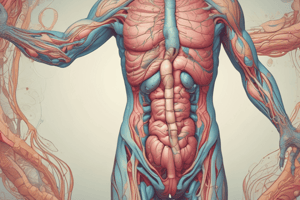Podcast
Questions and Answers
What is the primary mechanism of action of ondansetron in treating nausea?
What is the primary mechanism of action of ondansetron in treating nausea?
- D2 receptor antagonist
- M1 receptor antagonist
- 5-HT3 receptor antagonist (correct)
- NK1 receptor antagonist
What are common adverse effects of serotonin 5-HT3 antagonists?
What are common adverse effects of serotonin 5-HT3 antagonists?
- Dry mouth and dizziness
- Headache and constipation (correct)
- Visual disturbances and aggression
- Sedation and confusion
What triggers the release of serotonin from enterochromaffin cells?
What triggers the release of serotonin from enterochromaffin cells?
- Stress and anxiety
- Ingestion of fatty foods
- Inflammation in the digestive tract (correct)
- Physical exertion
Which treatment has been noted to cause fatal torsades des pointes?
Which treatment has been noted to cause fatal torsades des pointes?
Which of the following is NOT a phase of the vomiting process?
Which of the following is NOT a phase of the vomiting process?
What is a common side effect of prochlorperazine?
What is a common side effect of prochlorperazine?
Which receptor is primarily targeted by Aprepitant?
Which receptor is primarily targeted by Aprepitant?
Which condition is most likely to arise due to severe vomiting?
Which condition is most likely to arise due to severe vomiting?
What is a key indication for using scopolamine?
What is a key indication for using scopolamine?
What kind of actions do cannabinoids like dronabinol primarily have?
What kind of actions do cannabinoids like dronabinol primarily have?
Which of the following is a common side effect of antihistamines used for nausea?
Which of the following is a common side effect of antihistamines used for nausea?
Which drug is used for the prevention of nausea and vomiting after chemotherapy and surgery?
Which drug is used for the prevention of nausea and vomiting after chemotherapy and surgery?
What is a distinguishing feature of palonosetron compared to first-generation 5-HT3 antagonists?
What is a distinguishing feature of palonosetron compared to first-generation 5-HT3 antagonists?
Flashcards
Nausea
Nausea
An unpleasant feeling of needing to vomit.
Vomiting (Emesis)
Vomiting (Emesis)
The forceful expulsion of stomach contents.
Retching
Retching
Rhythmic contractions of muscles to expel contents.
5-HT3 Receptors
5-HT3 Receptors
Signup and view all the flashcards
Antiemetic Therapy
Antiemetic Therapy
Signup and view all the flashcards
Ondansetron
Ondansetron
Signup and view all the flashcards
Aprepitant
Aprepitant
Signup and view all the flashcards
Scopolamine
Scopolamine
Signup and view all the flashcards
Cannabinoid Hyperemesis Syndrome
Cannabinoid Hyperemesis Syndrome
Signup and view all the flashcards
Phases of Vomiting
Phases of Vomiting
Signup and view all the flashcards
Kinetosis
Kinetosis
Signup and view all the flashcards
Dolasetron
Dolasetron
Signup and view all the flashcards
Metabolic Alkalosis
Metabolic Alkalosis
Signup and view all the flashcards
Common Causes of Vomiting
Common Causes of Vomiting
Signup and view all the flashcards
Study Notes
Nausea and Vomiting Overview
- Nausea is an unpleasant feeling of impending vomiting, often accompanied by pallor and increased saliva. It's triggered by mediator release (e.g., 5-HT) from enterochromaffin cells in the digestive tract.
- Vomiting (emesis) is the forceful expulsion of stomach contents, involving spasmodic contractions of the stomach, esophagus, and abdominal muscles.
- Sialorrhea is excessive saliva production.
- Several factors, both intraperitoneal (e.g., infections, IBD, motility issues) and extraperitoneal (e.g., heart conditions, cancer, infections, metabolic issues, psychological causes), can cause nausea and vomiting.
- Chemotherapy, certain medications, and pregnancy are other potential triggers.
Vomiting Center and Process
- The vomiting center is located in the nucleus of the tractus solitarius and coordinates the vomiting reflex.
- This involves intricate actions from the throat, digestive system, and abdominal muscles.
- The process has distinct phases: pre-expulsion (gastric relaxation), retching (respiratory muscle contraction), and expulsion (strong abdominal muscle contractions and esophageal sphincter relaxation).
- Multiple pathways (gut, CTZ), brain regions, and sensory input can activate the vomiting center.
Causes and Treatment
- Diagnosis involves a comprehensive history and physical examination to determine the cause.
- Treatment focuses on addressing underlying conditions.
- Metabolic imbalances (e.g., hypokalemia, hypochloremia, metabolic alkalosis) are common complications of severe vomiting which should be corrected.
- Antiemetic therapy is administered based on the cause.
Antiemetic Medications
5-HT3 Receptor Antagonists (e.g., Ondansetron, Granisetron)
- Mechanism: Block 5-HT3 receptors.
- Uses: Chemotherapy, radiotherapy, and post-operative nausea/vomiting.
- Side effects: Headaches, constipation, prolonged QT interval.
Dopamine Receptor Antagonists (e.g., Prochlorperazine, Metoclopramide)
- Mechanism: Block dopamine receptors; Metoclopramide also increases gastric emptying & lower esophageal sphincter tone.
- Uses: Nausea/vomiting, gastroparesis (e.g., diabetic), persistent GERD.
- Side effects: Extrapyramidal symptoms, hyperprolactinemia, and other potential reactions.
NK1 Receptor Antagonists (e.g., Aprepitant, Fosaprepitant)
- Mechanism: Block substance P (NK1) receptors.
- Uses: Chemotherapy-induced nausea/vomiting.
- Side effects: Fatigue and gastrointestinal issues.
H1 Receptor Antagonists (e.g., Cinnarizine, Dimenhydrinate)
- Mechanism: Block histamine H1 receptors.
- Uses: Motion sickness and nausea.
- Side effects: Drowsiness and other potential responses.
Additional Antiemetic Agents
- Anticholinergic Drugs (e.g., Scopolamine): Used mainly for motion sickness and post-op nausea/vomiting, affecting acetylcholine receptors.
- Neurokinin Antagonist (e.g., Aprepitant):
- Cannabinoids (e.g., Dronabinol): A synthetic cannabinoid used for anorexia associated with weight loss, for nausea associated with chemotherapy.
- The synthetic cannabinoid can trigger a hyperemesis syndrome.
Chemotherapy-Induced Nausea/Vomiting (CINV)
- Different chemotherapy regimens have varying emetic potential.
- Treatment strategies are tailored based on emesis risk factors.
Pregnancy-Related Nausea/Vomiting
- Antihistamines (e.g., H1 antagonists, doxylamine, meclizine) often are safe for use in treating morning sickness.
General Note
- All medication use should be discussed with a healthcare professional.
Studying That Suits You
Use AI to generate personalized quizzes and flashcards to suit your learning preferences.





